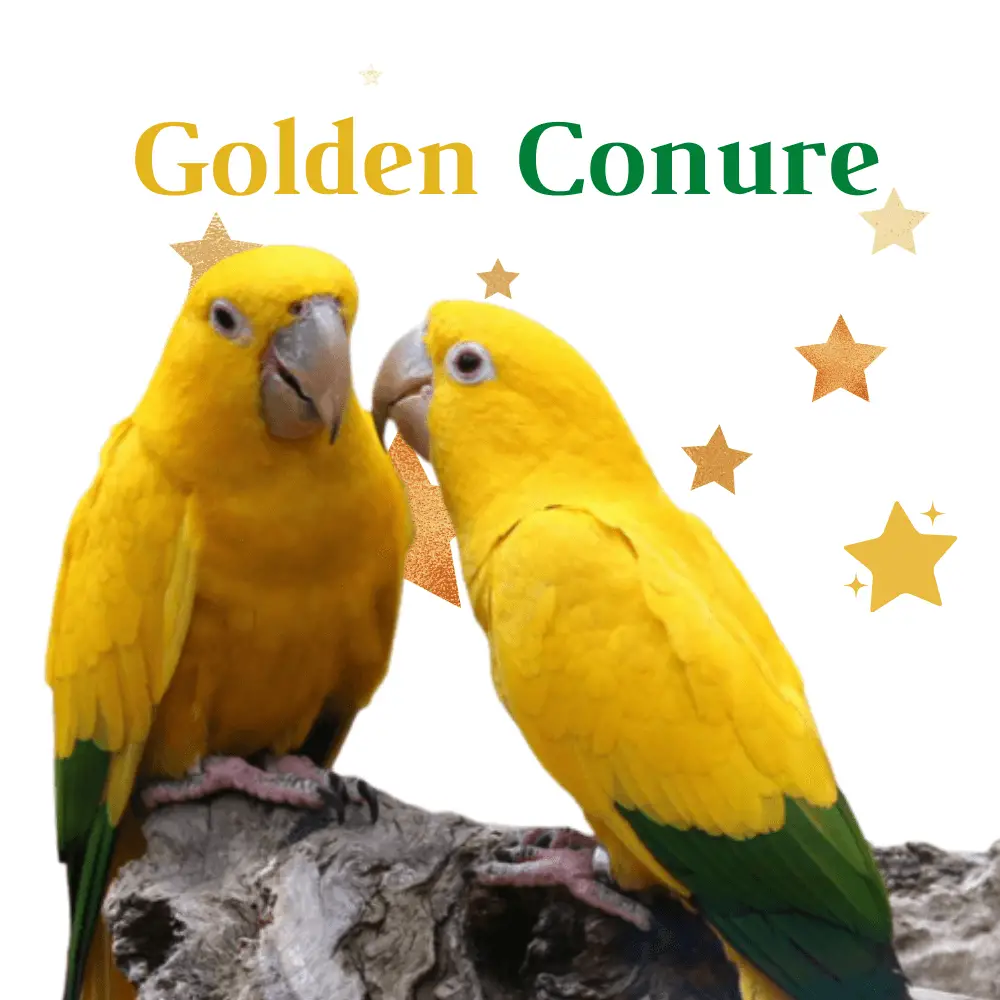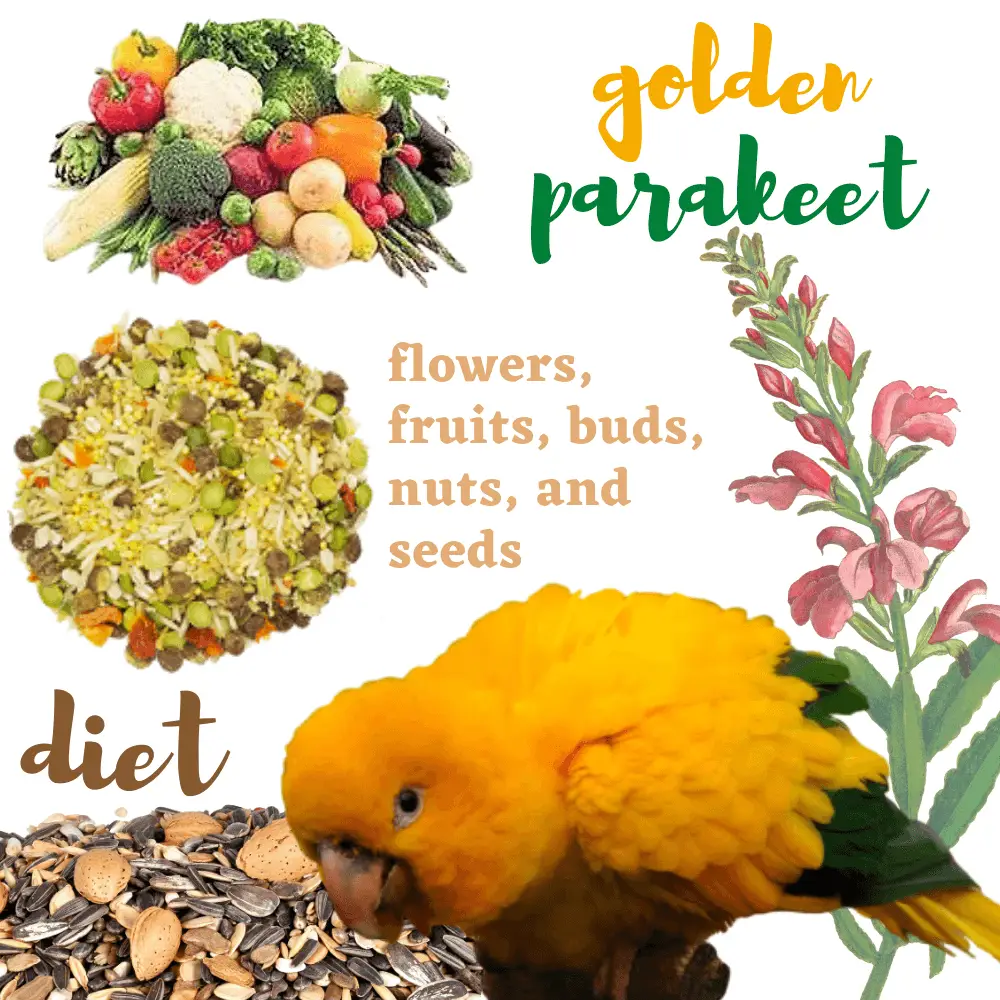
The Golden Conure ( Guaruba guarouba ) is a species of bird in the Psittacidae family, endemic to Brazil. This species is the only one in the genus Guaruba. It is sometimes classified in the genus Aratinga which includes other species.
The Golden Conure is arguably the most coveted of all the Conures. It is exceedingly rare and endangered in its natural habitat, and therefore protected from importation and collection from the wild, including through US regulations. golden parakeet is also classified in Appendix I on the red list of CITES. As such, its price is relatively high.
Order: Psittaciformes
Family: Psittacidae
Genus: Guaruba
Scientific name : Guaruba guarouba
Quote : ( Gmelin, JF, 1788)
Protonimo : psittacus Guarouba
Description
The Golden Conure (Guaruba guarouba) has all of the head, upper parts, lower parts, and tail a bright yellow. The large wings, primary Yes secondary are dark green (one or two yellow feathers in some flying birds). Underwing-coverts yellow, the lower part of the flight feathers dark yellow. Feathertail shafts are white in color.
The bill pale pink, browner on the base of the upper jaw; bare whitish orbital ring; Iris Orange to Brownish Orange; Rosaceae legs. Both sexes are similar.
Immature color olive-brown opaque streak dark green. In the transition to adulthood, the head, top of the tail, and back are the last to acquire the bright yellow color of adult plumage.
As its name suggests, the Golden Conure has mostly bright yellow plumage, complemented by dark green primary and secondary coverts. The eye rings are white, the beak greyish, the irises brown and the legs pink. This bird measures almost 34cm.
Juveniles are duller and have less yellow and greener plumage than adults. the head and neck are often green, the back is green and yellow, the upper part of the tail is mainly green, the chest is greenish and the legs are brown.
The species has been protected and listed in Appendix I of the Washington Convention since 1975. It belongs to the group of the 12 most endangered parrot species.
The Golden Conure inhabits the tropical primary forests of South America. Dwells in the humid tropical forests, avoiding the forests and marshes (seasonally flooded), Although, in the immediate breeding season, You will be able to wander in these habitats of the adjacent dry forests.
Gregarious in all seasons of the year. Observed in flocks of 3 30 birds, Although on a regular basis in groups between 6 y 10.
Male common roosts in tree cavities during the non-breeding season, using holes in the area, alternately in consecutive nights.
The habitual and regular use of rest and feeding areas is suspected to be due to the predictable daily routine. Sometimes seen feeding with other parrot species.
Golden Conure (Or Queen of Bavaria) Pros & Cons
SOURCE: Parrot Bliss
Behavior
The Golden Conure is rather erratic. It is a very affectionate and intelligent parrot species. In the wild, it flies a lot, while in captivity it prefers to climb and perform acrobatic tricks.
the golden parakeet is easily tamed, which helps make it a popular pet bird. This inveterate chewer, however, needs something to satisfy her vice in the aviary, through toys,
the golden parakeet can be prone to pecking, especially if she is not given enough space or stimulation. golden parakeet will therefore also be necessary to ensure that it is supplied with calcium, minerals, and vitamins regularly so that it can easily renew its energy reserves that the regrowth of the plumage is depleting.
She can speak relatively well, but also be quite talkative and noisy, which does not make her very suitable in an apartment.
Food

The Golden Conure, generally, feed-in tall forests, although they will overdo some crop plants; reported foods (all fruits or Pseudo-fruits ), They include palms of the genus Euterpe, this smells special Carnevale, Anacardium spruceanum,
(Anacardium occidental), Protium Yes Tetragastris, Visa quail, Inga, Byrsonima crassifobia, Carapa guianensis, Cecropia Yes Oenocarpus banaba; Alsoflowers and buds (eg Symphonia ), Yes crops such as corn and mango in certain areas.
In the wild, it lives in humid forests, in pairs, or in small family groups of around twenty individuals. Its diet consists of flowers, fruits, buds, nuts, and seeds.
the golden parakeet consumes in particular the seeds of the croton mitogenesis, the fruits of the byrsonima crisp, and the acai. In captivity, its ration will be rather composed of a mixture of seeds for large parakeets, extrudates, fruits, and vegetables.
Reproduction
Guaruba eggs guarouba – Museum of Toulouse
Topaz the Golden Conure Dancing
SOURCE: George Leo
golden conure price
between $1,400-$2,000
Distribution
The Golden conure parrot is endemic to the Brazilian Amazon. It is in danger of extinction.
Endemic to the Amazon, south of Amazona in Brazil, from the west bank of the Tapajós River, east through the basins of the Xingu River, and north of Tocantins to 5 N°, To, and up at the eastern bank of the Turiacu River in West Maranhão.
Has only been observed in the Island of Marajó and prevents the forests and marshes (for example, immediately south of the Amazon ). Recent records in Rondônia Yes Mato Grosso, far from their known range, suggest a little-known distribution.
Apparently, they are distributed in large areas, but it is unclear whether the movements are predictable or associated with, for example, the seasonal availability of food.
Rare across the range and probably in decline due to the very large, rapid, and continuous deforestation and fragmentation of forests, both in the Western Amazon and in the Eastern.
Captivity
If I Had To Choose Between A GOLDEN Conure & CAPE Parrot, Which Would I Choose?
SOURCE: Parrot Bliss
Preservation
The construction of the Tucurui Dam, which was completed in 1984, displaced 35,000 settlers from their homes to adjacent territories and brought rapid deforestation.
Before the construcicón dam, Fauna in the lower basin of the Tocantins was considered among the richest and most diverse in the world.
the golden parakeet is estimated you have 117 species of mammals and 294 species of birds that have been moved. And then 120 species of amphibians and reptiles were affected.
The population of the Golden Conure was initially in a range of between 1,000-2,499 individuals, based on an assessment of known records, descriptions of abundance, and range size. However, recent information suggests that the population may be higher.
( Laranjeiras and Cohn-Haft 2009 ), and a recent study along the Tapajós River by Laranjeiras (2011) said it was so common in the study area like other Psittacidas, not threatened.
Based on this information, the population is placed in the band 10,000-19,999 individuals, It means to understand c. 6,600-13,400 mature individuals.
According to records from the International Species Information System, there is a population of 213 individuals scattered across different zoos.
read more:




















